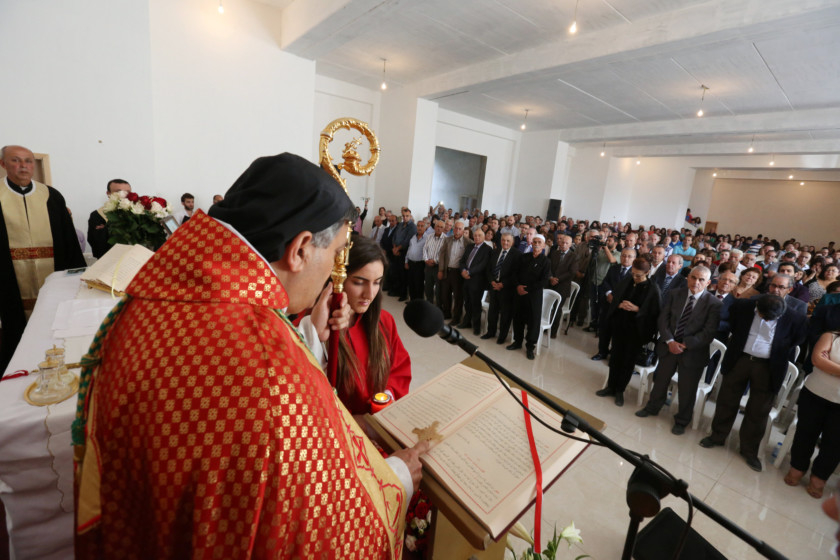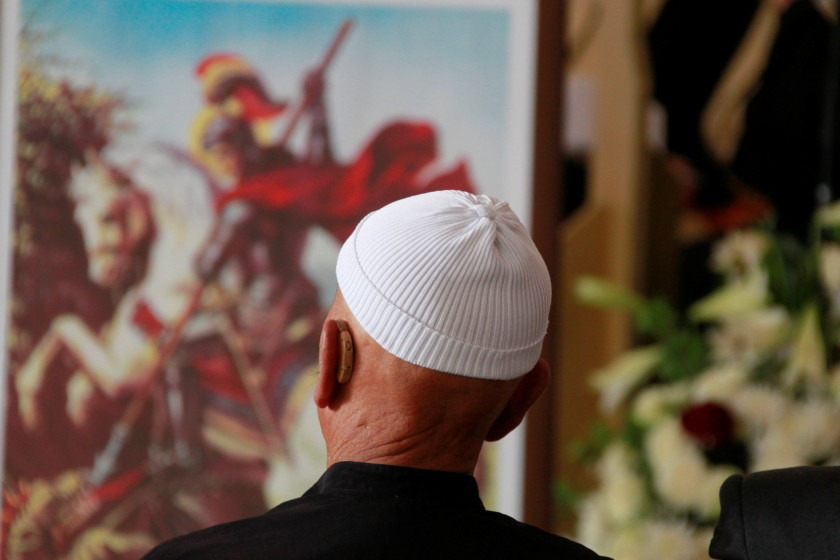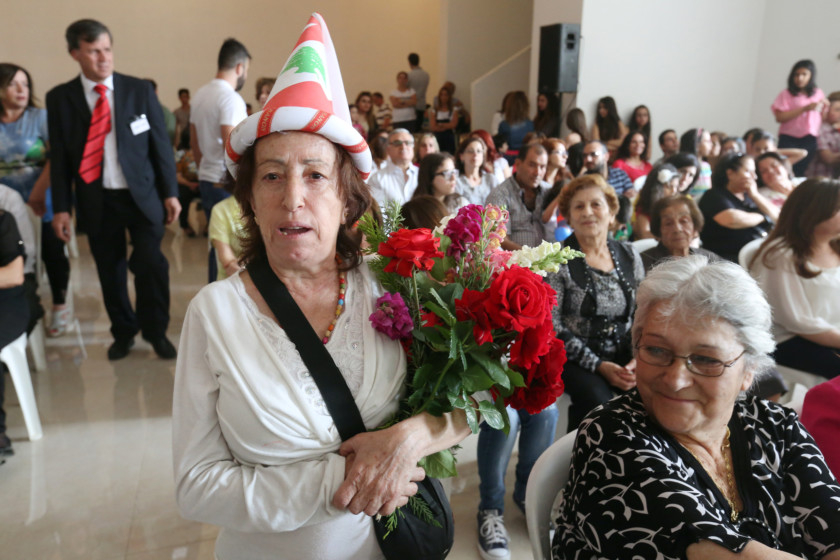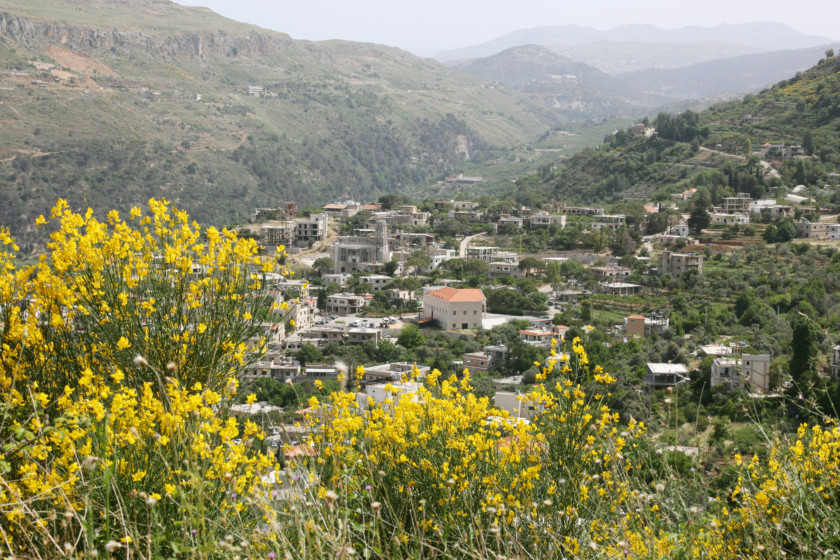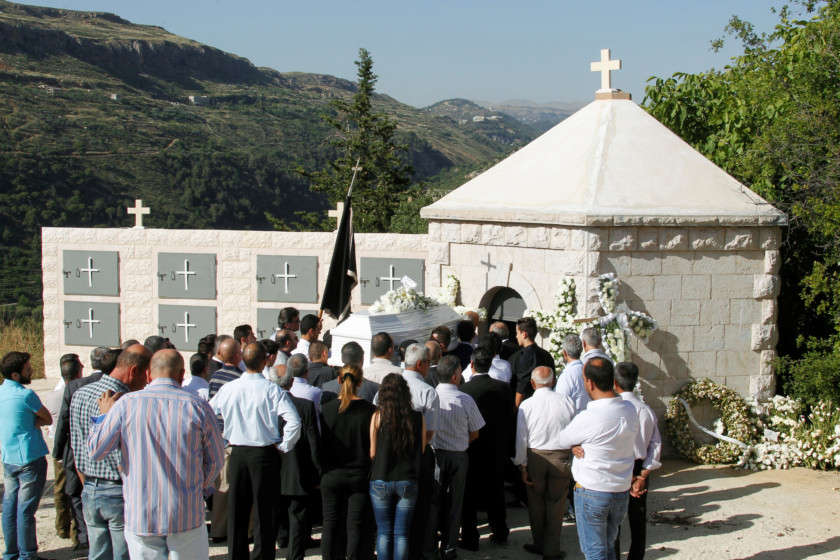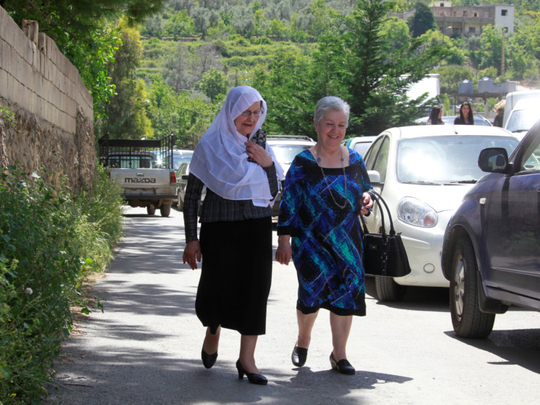
Brih, Lebanon: It took more than three decades and an unexpected death to bring the village of Brih back together.
Nestled among fruit trees and olive groves in a rugged valley, Brih was populated for generations by both Christians and Druze — adherents to a small but influential offshoot of Islam that emerged in the 11th century.
But when Lebanon descended into civil war in the 1970s, the two communities found themselves pitted against each other. In 1983, when the last Christians fled, Druze villagers moved into abandoned Christian houses; others were razed.
Then last November, Georges Chalhoub, a 56-year-old shopkeeper whose forefathers had come from Brih but who had lived near Beirut for much of his life, was killed in a car accident. Chalhoub had dreamed of moving back to his ancestral village and so his family decided to bury him there.
The funeral created a moment of amity. Christians and Druze carried his coffin together, reviving a local custom. The procession passed by the site where the Chalhoub family home had once stood, and where they are now building a new house.
“The Druze carried him with us from the start of the village. The reception was beautiful. There was great respect for the body,” said Khalil Chalhoub, Georges’ 89-year-old father.
Twenty-six years after the end of Lebanon’s civil war, the story of Brih is a reminder of how long it can take to stitch together societies torn apart by war. Much as in Syria and Iraq today, Lebanon was shattered by its 15-year-long war. Villages and neighbourhoods in which Muslims and Christians had lived side by side for centuries were reshaped. Hundreds of thousands of people retreated into separate enclaves controlled by sectarian militias.
In Brih, whose population is 4,000, it was not until 2014 that a government-sponsored settlement opened the way for Christians to return. Across Lebanon, very few displaced people have moved back to areas from which they fled. Deep sectarian fractures continue to hurt the country, from villages like Brih right up to the national parliament. The lesson for Syria and Iraq is this: even when peace comes, divisions can last for decades.
The Chalhoub family returned to rebuild in Brih only after national leaders oversaw the reconciliation agreement for the village. As with most other Christians from the village, their return has so far been limited to weekend visits. And it was not until Georges Chalhoub’s funeral that they sensed a true spirit of reconciliation.
“It’s been some two years now since the official reconciliation, but there wasn’t this kind of interaction,” Khalil Chalhoub said. “We opened the door, and there was a good response.” The family hosted mourners at the building site where Chalhoub was building the new family home, arranging chairs and offering visitors coffee. Druze from Brih and the surrounding area — uninvited, but welcome — arrived to pay their respects.
“I did not know him, but I knew he was from my village,” said Hamza Abou Ezzedine, who is 32, and has only ever known Brih as a Druze village. “This is a duty.”
THE SPLIT
The first major outburst of violence in Brih came in 1977, two years into the civil war. Druze gunmen opened fire at a church, killing 12. The next day, many Christians fled the village.
Five years later, the village became a battleground in the so-called ‘Mountain War’ that erupted after the 1982 Israeli invasion of Lebanon. Israel wanted to crush the Palestine Liberation Organisation and install a new Lebanese president friendly to Israel. The Christian Lebanese Forces militia saw the Israel presence as a chance to challenge Druze dominance of the Chouf mountains.
But a year later Israel withdrew from the Chouf area and a full-scale civil war between Christians and Druze began. With the defeat of the Lebanese Forces, the remaining Christians were forced from Brih and dozens of other villages. An estimated 250,000 Christians fled the mountains — the single biggest sectarian displacement of the civil war. In Brih, Christian homes were destroyed and two churches blown up.
Theodor Hanf, in his Coexistence in Wartime Lebanon, said that it took just two weeks for the Chouf to be nearly entirely cleansed of Christians. The Druze spiritual leader at the time declared Christians would never again live in the area.
In 1993, the government set up a ministry to oversee the return of people who had been displaced. It took years before progress was seen in the Chouf. Christians began trickling back to Christian villages, but agreeing terms for their return to what had been mixed villages was much harder. The Lebanese government has sponsored two dozen reconciliation agreements in the Chouf, each of them amounting to an individual peace process.
The Brih agreement was one of the toughest to finalise, said Ahmad Mahmoud, director-general of the Ministry of the Displaced. “In a place like Brih, you had Christian and Druze homes next to each other. They know that so-and-so killed so-and-so,” he said. “You have to convince someone who lost his father to invite over his killer and offer him coffee.”
Mahmoud keeps leather-bound copies of every reconciliation agreement on a shelf in his Beirut office, each page signed by the villager and official involved. Brih, he said, “was a difficult story. Their wounds are deep”. Reconciliation in Brih required, among other things: Druze families to move out of dozens of Christian homes they had occupied for three decades; the demolition of a Druze community centre built on Christian land; the construction of a new Druze community centre; the construction of two new churches; the state paying compensation to Druze forced to evacuate homes, and to Christians who needed to repair or rebuild theirs; and inquiries into the fate of people still missing after the conflict.
Two years on, very few Christians have moved back to Brih permanently. Most have built their lives in richer urban areas and are reluctant to leave. As well, the compensation to rebuild homes — an initial payment of $10,000 (Dh36,729) per person followed by another later on — is way short of what is needed. Many are still waiting to receive the first payment. For most, “return” has meant weekend visits.
Hanna Hassoun, now 83, used to be the director of Brih’s secondary school until he fled with his family in 1977, thinking they would be gone for a few months at most. He did not return until two years ago.
Hassoun remembers when the school had 500 pupils and 30 teachers. There was no school building, so the school rented houses they turned into classrooms. He was president of a village club.
“We had lots of activities, but then the events came and drove people apart,” he said at his apartment in Antelias, a Christian suburb north of Beirut.
His house, a two-storey stone villa, was destroyed in the 1980s. The Druze later erected a community centre, known as the Bayt, on the site. The fate of the Bayt became a major sticking point during the reconciliation talks. As mediators sought to reach a settlement, Hassoun and his neighbour rejected offers to sell their land. Eventually, the Bayt was knocked down and a new one constructed, opening the way to the reconciliation agreement.
“The person with no land has no existence,” he said. “I tell my children, if we still have land in Brih, never sell it. Leave it to your children and your grandchildren.”
The process in Brih echoes Lebanon’s national approach to dealing with the peace. The post-war administration agreed a general amnesty for all political crimes perpetrated before 1991 — an attempt to turn the page by allowing civil wartime leaders to move into government.
That approach has been widely criticised. The International Centre for Transitional Justice (ICTJ), an organisation set up to help societies deal with the legacy of war, says short-term peace was chosen at the expense of justice. That has left Lebanon vulnerable to spasms of violence and political conflict since.
“What should have been done is to involve victims, to talk more about the war. Truth-seeking is a main condition for a real reconciliation,” the ICTJ’s Nour Al Bejjani said.
The Chouf agreements, while helpful, have not been built on solid ground.
“That’s why you see some Christians feel insecure about going back to their villages.”
The fragility of the peace surfaced during local elections in Brih in May, the first since the 1960s. Candidates formed two rival lists for the 12 council seats, each of them split evenly between Christians and Druze. That arrangement was in line with the wishes of Druze leader Waleed Junblatt, a civil war leader whose family has dominated the area politically for decades. The aim was to achieve sectarian balance — and voters were encouraged to elect one of the lists in its entirety. The election drew hundreds of Christians to the village. More than 1,400 people voted in all, a turnout of 64 per cent.
In the end, though, Brih ended up with seven Druze and five Christian winners.
Eid Hassoun, a Christian lawyer who won a seat as part of the ‘Coexistence’ list, said just 15 more votes would have yielded a balanced outcome.
“The election, instead of bringing a result that put the village at ease caused a shock,” he said.
Eid blamed members of both communities: A Christian independent had falsely claimed that Christians were secretly aiming to secure more than half the seats. That had prompted a group of Druze voters to submit Druze-only ballots late in the day. The multitude of independent Christian candidates had also played a role by diluting the vote, he said.
Efforts to redress the imbalance failed. “We tried to find a solution, but the solution was in the ballot box and the result that emerged,” said Nizar Yehya, the Brih representative of the Druze-dominated Progressive Socialist Party led by Junblatt.
Christians said the tensions began to ease a few weeks later. The council held its first meeting, elected a Christian chairman, and agreed that any sensitive issues should be approved by consensus rather than a vote.
Another sticking point may be harder to resolve. Former Lebanese Forces commander Boulous Khalil was the last Christian fighter to withdraw in 1983 and is possibly the only Brih Christian yet to return.
Khalil, 54, and known as ‘The Hero’, dismisses the reconciliation agreement as superficial.
“It was a political act, not one of consensus and coexistence,” he said in his office at the gym he owns in the Beirut Christian district of Ain Al Romaneh. On the wall hung a crucifixion. A biography of the late Lebanese Forces leader and Lebanon’s former president Bashir Gemayel sat on his bookcase.
“If you don’t expose the past, and put your finger on the wound, you cannot reach the present to live in security,” he said.
Khalil said Druze villagers would not welcome him. “There is a veto on me,” he said.
Druze community leaders deny that. Karim Yehya, a wartime adversary of Khalil’s, visited Khalil at his gym earlier this year to urge him to visit Brih. It was the first time they had seen each other since the war, said Yehya, 67.
Khalil said Junblatt needed to tell the people of Brih “that this guy wants to visit and nobody must touch him”. Junblatt declined to be interviewed for this article.
Christian villagers hope the completion of the two new churches will encourage more of their community back. The reconstruction was a sensitive process: excavators had to take care to locate the bodies of the 12 Christians killed 39 years ago and buried beneath the rubble of one of the churches, St. George. That church has been rebuilt 30 per cent bigger than its predecessor and the remains were reburied in the church in August.
In April, there was standing room only for the first service at St. George’s since the 1977 shooting. Several hundred people, including Druze villagers, packed a reception hall. Loud applause greeted the arrival of the priests as they made their way up the aisle. Swinging a thurible, one of them stopped to kiss a man in a traditional black Druze shirt, shirwal trousers and white hat seated in the front row. Before communion, the priest asked God to “deepen and strengthen” the Christian return.
Ghandi Yehya, who lost five members of his family when fighting erupted in 1982, said since Christians began coming back “there has not been a single big problem, or slap thrown”. Still, he said, it is best to avoid discussion of the past.
“I might say something others won’t accept, even though it is a truth.”


